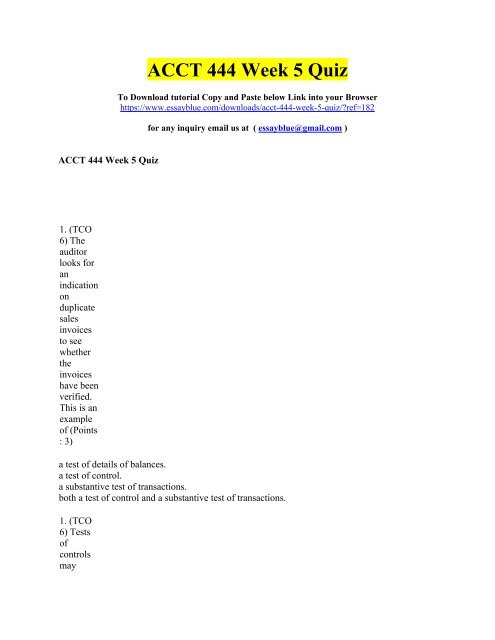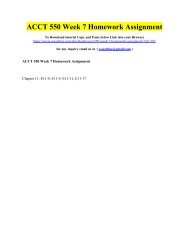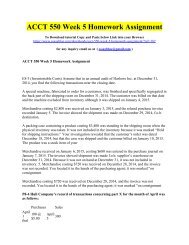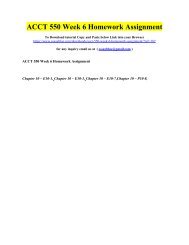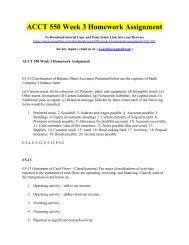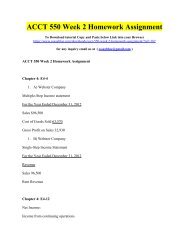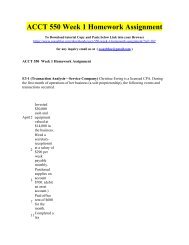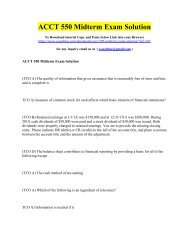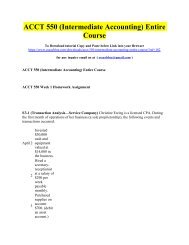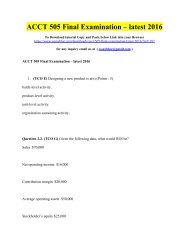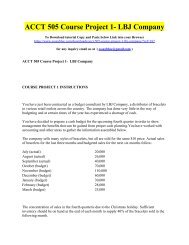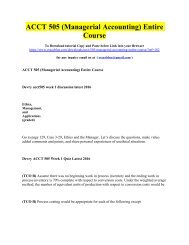ACCT 444 Week 5 Quiz
Create successful ePaper yourself
Turn your PDF publications into a flip-book with our unique Google optimized e-Paper software.
<strong>ACCT</strong> <strong>444</strong> <strong>Week</strong> 5 <strong>Quiz</strong><br />
To Download tutorial Copy and Paste below Link into your Browser<br />
https://www.essayblue.com/downloads/acct-<strong>444</strong>-week-5-quiz/?ref=182<br />
for any inquiry email us at ( essayblue@gmail.com )<br />
<strong>ACCT</strong> <strong>444</strong> <strong>Week</strong> 5 <strong>Quiz</strong><br />
1. (TCO<br />
6) The<br />
auditor<br />
looks for<br />
an<br />
indication<br />
on<br />
duplicate<br />
sales<br />
invoices<br />
to see<br />
whether<br />
the<br />
invoices<br />
have been<br />
verified.<br />
This is an<br />
example<br />
of (Points<br />
: 3)<br />
a test of details of balances.<br />
a test of control.<br />
a substantive test of transactions.<br />
both a test of control and a substantive test of transactions.<br />
1. (TCO<br />
6) Tests<br />
of<br />
controls<br />
may
include<br />
which of<br />
the<br />
following<br />
types of<br />
evidence?<br />
(Points :<br />
3)<br />
Observation<br />
Reperformance<br />
Inquiries<br />
All of the above<br />
1. (TCO<br />
6) For<br />
efficiency,<br />
tests of<br />
controls<br />
are<br />
frequently<br />
done at<br />
the same<br />
time as<br />
(Points :<br />
3)<br />
analytical procedures.<br />
compliance tests.<br />
tests of transactions.<br />
tests of details of balances.<br />
2. (TCO 6)<br />
Analytical<br />
procedures<br />
are<br />
defined in<br />
the<br />
auditing<br />
standards<br />
as (Points<br />
: 3)
compliance<br />
tests.<br />
substantive<br />
tests.<br />
tests of<br />
controls.<br />
helpful<br />
procedures<br />
not<br />
possessing<br />
the validity<br />
of other<br />
tests<br />
available to<br />
the auditor.<br />
2. (TCO 6) Which of the following is not a direct result of performing analytical procedures?<br />
(Points : 3)<br />
Identify areas of potential misstatements.<br />
Reduce detailed audit risk.<br />
Understand the client’s business.<br />
Identify specific errors in the accounts.<br />
2. (TCO 6)<br />
Analytical<br />
procedures<br />
may be<br />
classified<br />
as being<br />
primarily<br />
(Points :<br />
3)<br />
tests of controls.<br />
substantive tests.<br />
tests of ratios.<br />
tests of details of balances.<br />
3. (TCO<br />
6) Which<br />
of the
following<br />
audit<br />
tests is<br />
usually<br />
the least<br />
costly to<br />
perform?<br />
(Points :<br />
3)<br />
Analytical<br />
procedures<br />
Tests of<br />
controls<br />
Tests of<br />
balances<br />
Substantive<br />
tests of<br />
transactions<br />
3. (TCO 6) Which of the following audit tests is usually the most costly to perform? (Points : 3)<br />
Analytical procedures<br />
Tests of controls<br />
Tests of balances<br />
Substantive tests of transactions<br />
4. (TCO<br />
6) Which<br />
of the<br />
following<br />
tests<br />
commonly<br />
occur<br />
together?<br />
(Points :<br />
3)<br />
Substantive<br />
tests of<br />
transactions<br />
and tests of<br />
controls<br />
Substantive
tests of<br />
transactions<br />
and obtaining<br />
an<br />
understanding<br />
of internal<br />
controls<br />
Analytical<br />
procedures<br />
and tests of<br />
controls<br />
All of the<br />
above<br />
4. (TCO 6) Which of the following relationships between types of tests and audit evidence is not<br />
correct? (Points : 3)<br />
Tests of details and documentation<br />
Tests of controls and observation<br />
Tests of details and observation<br />
Substantive tests of transactions and reperformance<br />
5. (TCO<br />
6) The<br />
sequence<br />
of steps<br />
in<br />
gathering<br />
evidence<br />
as the<br />
basis of<br />
the<br />
auditor’s<br />
opinion<br />
are<br />
(Points :<br />
3)<br />
substantive<br />
tests,<br />
initial<br />
assessment<br />
of control<br />
risk, and
tests of<br />
controls.<br />
initial<br />
assessment<br />
of control<br />
risk,<br />
substantive<br />
tests, and<br />
tests of<br />
controls.<br />
initial<br />
assessment<br />
of control<br />
risk, tests<br />
of<br />
controls,<br />
and<br />
substantive<br />
tests.<br />
tests of<br />
controls,<br />
initial<br />
assessment<br />
of control<br />
risk, and<br />
substantive<br />
tests.<br />
5. (TCO 6) The purpose of tests of controls is to provide reasonable assurance that the (Points :<br />
3)<br />
accounting treatment of transactions and balances is valid and proper.<br />
internal control procedures are functioning as intended.<br />
entity has complied with GAAP disclosure requirements.<br />
entity has complied with requirements of quality control.<br />
6. (TCO<br />
9) It is<br />
important<br />
that sales<br />
be billed<br />
and<br />
recorded<br />
in the
journal as<br />
soon as<br />
possible<br />
after<br />
(Points :<br />
3)<br />
the order is received.<br />
the order is received and credit is approved.<br />
credit is approved and it is verified that there is enough<br />
inventory to fill the order.<br />
the shipment takes place.<br />
6. (TCO 9) The use of prenumbered sales invoices is meant to<br />
prevent (Points : 3)<br />
the failure to bill or record sales.<br />
duplicate billings and recording of sales.<br />
both A and B are correct.<br />
neither A nor B is correct.<br />
6. (TCO 9)<br />
Prenumbered<br />
documents<br />
will only be<br />
useful for<br />
control<br />
purposes if<br />
(Points : 3)<br />
a different numerical sequence is used for each company.<br />
the sequence is accounted for periodically.<br />
employees do not have access to the complete sequence.<br />
All of the above<br />
7. (TCO 9)<br />
Which one<br />
of the<br />
following is<br />
not an<br />
auditor’s<br />
concern
about a key<br />
authorization<br />
point in the<br />
sales or<br />
collection<br />
cycle?<br />
(Points : 3)<br />
The receiving<br />
room must<br />
have<br />
authorization<br />
before<br />
releasing<br />
items to<br />
inventory<br />
control.<br />
Credit must<br />
be authorized<br />
before the<br />
sale.<br />
Goods must<br />
be shipped<br />
after the<br />
authorization.<br />
Prices must<br />
be<br />
authorized.<br />
7. (TCO 9) At which point in an ordinary sales transaction would a lack of specific authorization<br />
be of least concern to the auditor? (Points : 3)<br />
Granting of credit<br />
Shipment of goods<br />
Determination of discounts<br />
Selling of goods for cash<br />
8. (TCO<br />
9) The<br />
creditgranting<br />
functions<br />
should be<br />
separated
from<br />
which of<br />
the<br />
following?<br />
(Points :<br />
3)<br />
Purchasing functions<br />
Manufacturing function<br />
Sales function<br />
None of the above<br />
9. (TCO 9)<br />
When<br />
designing<br />
substantive<br />
tests of<br />
transactions<br />
for sales, the<br />
auditor is<br />
concerned with<br />
the possibility<br />
of several<br />
types of<br />
misstatements.<br />
Which of the<br />
following is<br />
not one of the<br />
types of these<br />
misstatements?<br />
(Points : 3)<br />
Sales being included in the journal for which no shipment was made<br />
Sales to related parties, such as officers and subsidiaries<br />
Sales recorded more than once<br />
Shipments being made to nonexistent customers and recorded as sales<br />
10. (TCO<br />
9) A key<br />
internal<br />
control in
the sales<br />
and<br />
collection<br />
cycle is<br />
the<br />
separation<br />
of duties<br />
between<br />
cash<br />
handling<br />
and<br />
record<br />
keeping.<br />
The<br />
objective<br />
most<br />
directly<br />
associated<br />
with this<br />
control is<br />
to verify<br />
that<br />
(Points :<br />
3)<br />
cash receipts recorded in the cash receipts journal are reasonable.<br />
cash receipts are properly classified.<br />
recorded cash receipts result from legitimate transactions.<br />
existing cash receipts are recorded.<br />
10. (TCO 9)<br />
Which one<br />
of the<br />
following<br />
would the<br />
auditor<br />
consider to<br />
be an<br />
incompatible<br />
operation if<br />
the cashier<br />
receives<br />
remittances<br />
from the
mailroom?<br />
(Points : 3)<br />
The cashier prepares the daily deposit.<br />
The cashier makes the deaily deposit at a local bank.<br />
The cashier posts the receipts to the accounts receivable subsidiary ledger cards.<br />
The cashier endorses the checks.


